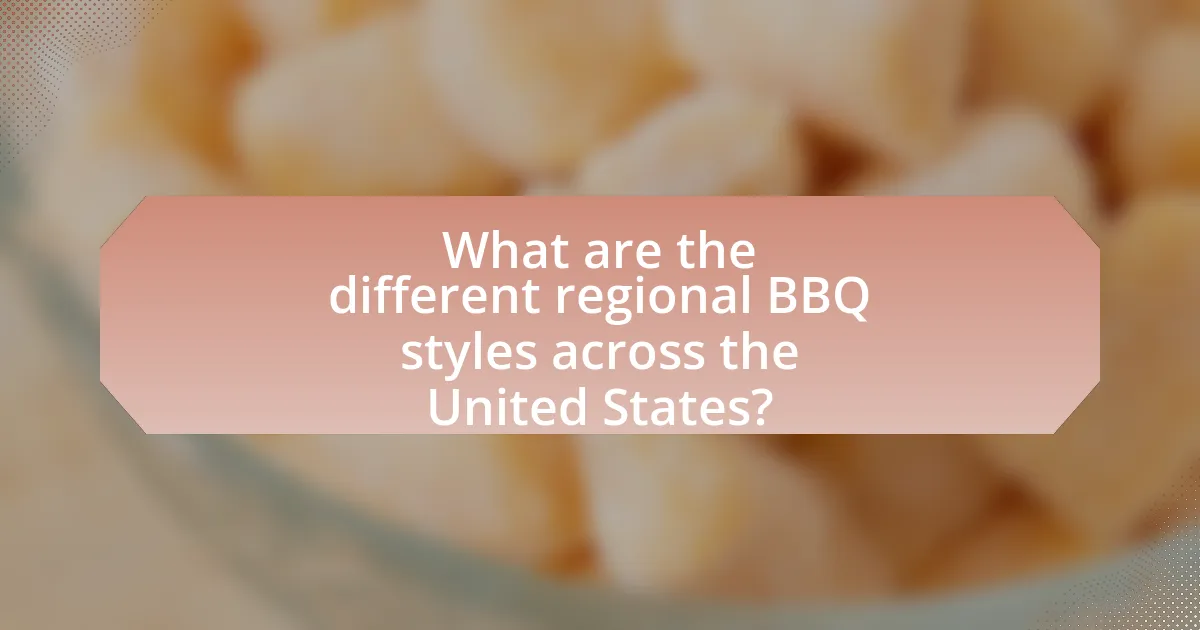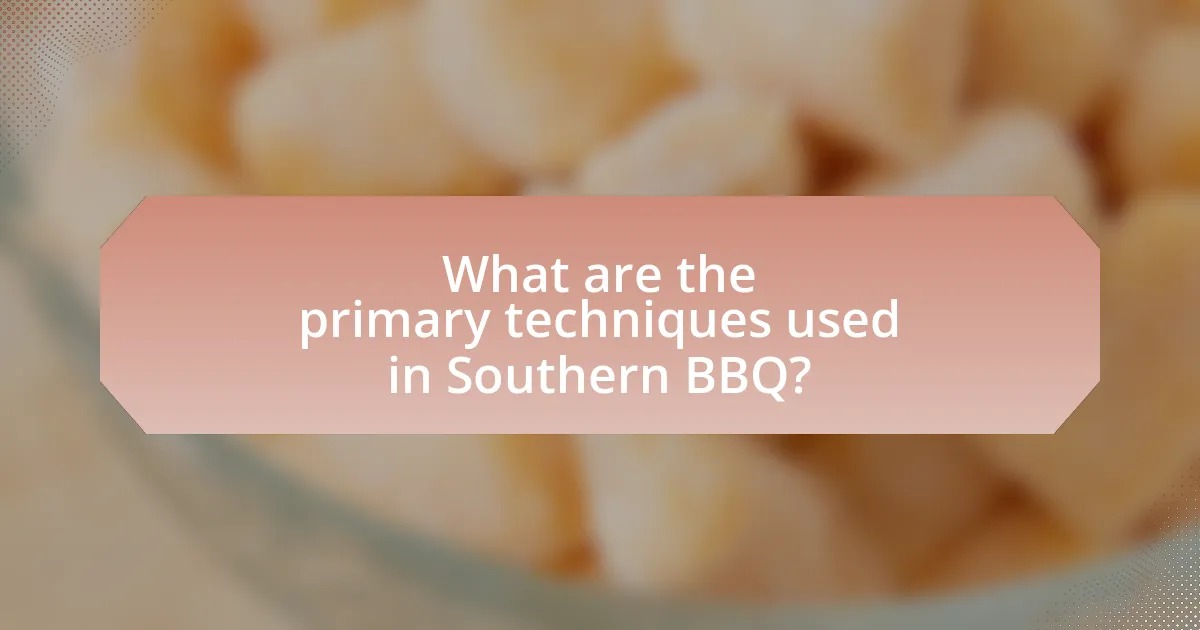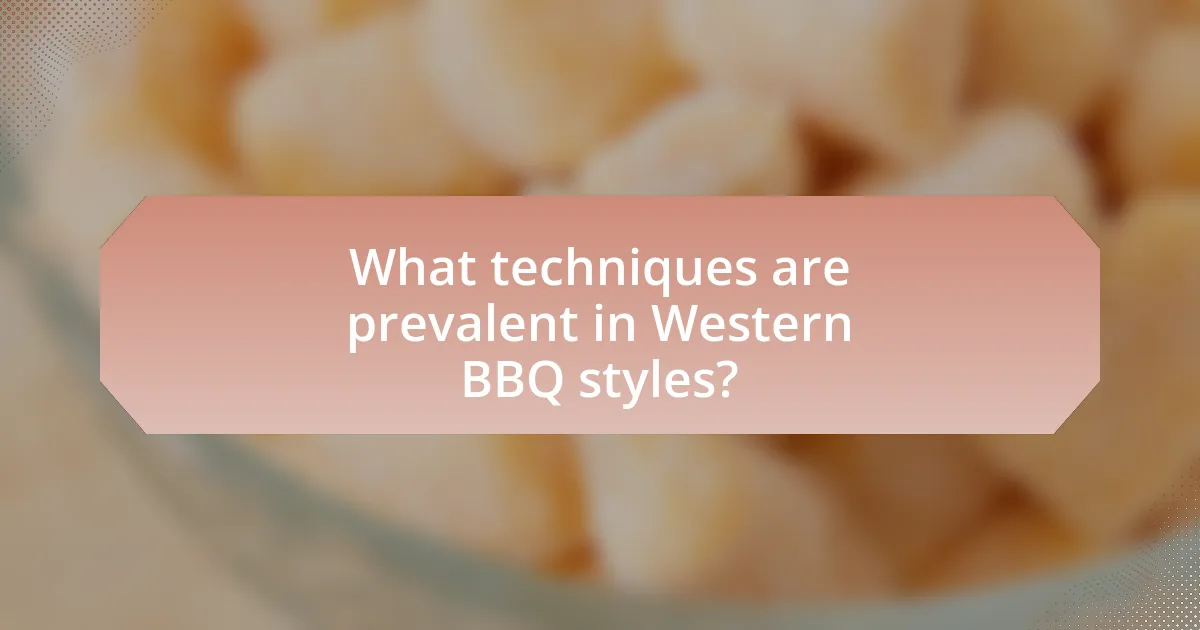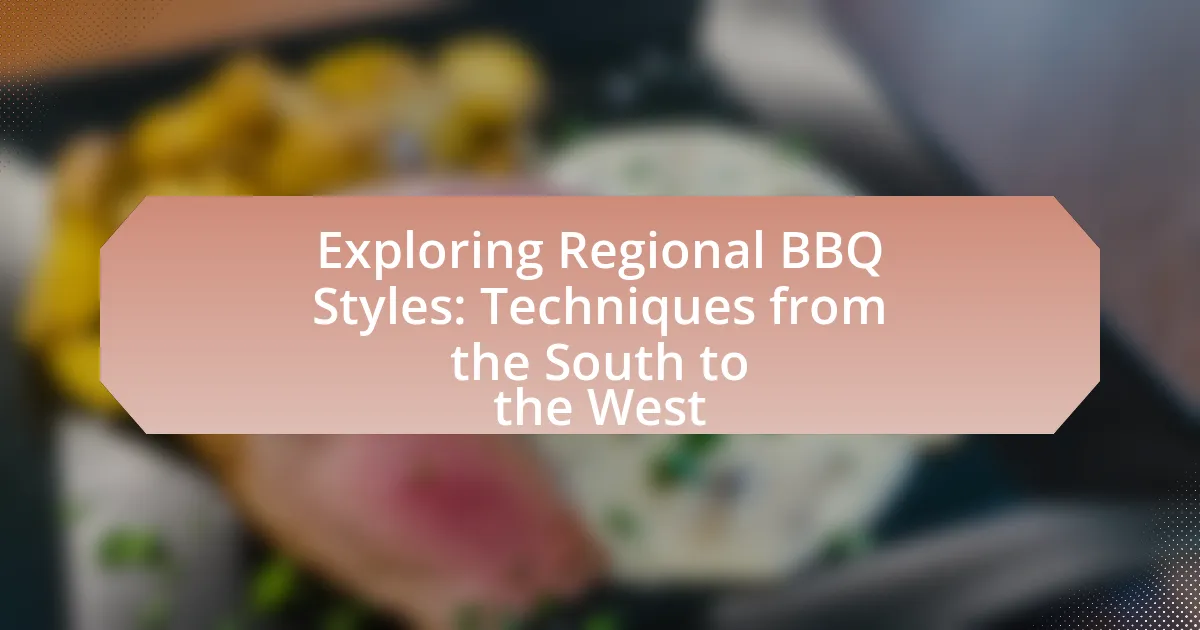The article explores the diverse regional BBQ styles across the United States, highlighting the distinct characteristics of Southern and Western BBQ techniques. It details the unique flavors, cooking methods, and cultural significance of various styles, including Texas, Kansas City, Memphis, Carolina, and Alabama BBQ. The discussion encompasses key techniques such as slow smoking, grilling, and the use of specific marinades and rubs, as well as the communal aspect of BBQ in American culture. Additionally, it examines how local traditions and ingredients influence BBQ practices, providing insights into mastering these techniques at home.

What are the different regional BBQ styles across the United States?
The different regional BBQ styles across the United States include Texas, Kansas City, Memphis, Carolina, and Alabama BBQ. Texas BBQ is known for its emphasis on beef, particularly brisket, often seasoned with a simple rub and smoked over post oak. Kansas City BBQ features a variety of meats, including pork ribs and burnt ends, typically slathered in a thick, sweet tomato-based sauce. Memphis BBQ is famous for its pulled pork, often served with a vinegar-based sauce, and is characterized by dry rubs. Carolina BBQ is distinguished by its use of whole hog and vinegar-based sauces, with variations between Eastern and Western North Carolina styles. Alabama BBQ is unique for its white sauce, made with mayonnaise, which is typically used on chicken. Each style reflects regional preferences and cooking techniques, contributing to the rich diversity of American barbecue culture.
How do Southern BBQ styles differ from those in the West?
Southern BBQ styles primarily focus on slow-cooking methods, often using wood smoke, and feature a variety of meats such as pork, while Western BBQ styles tend to emphasize grilling and may include a broader range of meats like beef and chicken. Southern BBQ is characterized by regional sauces, such as vinegar-based in North Carolina or tomato-based in Kansas City, whereas Western BBQ often incorporates dry rubs and sauces that are sweeter and thicker, particularly in Texas. The cooking techniques also differ; Southern BBQ often involves smoking meats for extended periods, while Western BBQ may utilize quicker grilling methods, reflecting regional preferences and available resources.
What are the key characteristics of Southern BBQ?
Southern BBQ is characterized by slow cooking methods, often using indirect heat and wood smoke, which imparts a distinct flavor to the meat. This style typically features pork as the primary protein, particularly pulled pork, and is often accompanied by a variety of regional sauces, such as vinegar-based, tomato-based, or mustard-based sauces, depending on the specific Southern region. The cooking process often involves marinating or seasoning the meat with a dry rub, which includes spices like paprika, black pepper, and cayenne. Additionally, Southern BBQ is known for its communal dining culture, where meals are often shared among family and friends, highlighting the social aspect of this culinary tradition.
What defines Western BBQ techniques?
Western BBQ techniques are characterized by the use of direct grilling and smoking methods, often employing wood or charcoal for flavor. These techniques emphasize high heat cooking, resulting in a seared exterior while maintaining moisture within the meat. Additionally, Western BBQ often incorporates regional sauces and rubs, which can vary significantly, reflecting local ingredients and culinary traditions. For example, in Texas, brisket is commonly smoked for long periods, while in California, grilling vegetables and seafood is prevalent. The emphasis on flavor profiles and cooking methods showcases the diversity within Western BBQ, making it distinct from other regional styles.
Why is regional BBQ important to American culture?
Regional BBQ is important to American culture because it reflects the diverse culinary traditions and regional identities across the country. Each region, from Texas to the Carolinas, has developed unique BBQ styles that incorporate local ingredients, cooking techniques, and cultural influences, showcasing the rich tapestry of American history. For example, Texas BBQ is known for its emphasis on beef brisket and smoke, while Carolina BBQ often features pulled pork with vinegar-based sauces. This variety not only highlights regional pride but also fosters community and social gatherings, making BBQ a central element of American culinary heritage.
How does BBQ reflect local traditions and ingredients?
BBQ reflects local traditions and ingredients by incorporating regional flavors, cooking methods, and cultural practices unique to each area. For instance, Southern BBQ often features pork and is characterized by slow cooking methods, influenced by African American culinary traditions, while Texas BBQ emphasizes beef brisket, showcasing the state’s cattle ranching heritage. Additionally, local ingredients such as specific types of wood for smoking or regional sauces, like vinegar-based in the Carolinas or tomato-based in Kansas City, further illustrate how BBQ is a culinary expression of local identity and resources.
What role does BBQ play in community gatherings and celebrations?
BBQ serves as a central element in community gatherings and celebrations by fostering social interaction and cultural identity. It acts as a communal activity where people come together to share food, stories, and traditions, enhancing community bonds. Historically, BBQ has been integral to various cultural celebrations, such as Independence Day in the United States, where grilling outdoors is a common practice, reflecting regional styles and techniques that vary from the South to the West. This culinary tradition not only provides a means of nourishment but also creates a festive atmosphere, encouraging participation and collaboration among community members.

What are the primary techniques used in Southern BBQ?
The primary techniques used in Southern BBQ include slow smoking, direct grilling, and indirect cooking. Slow smoking involves cooking meat at low temperatures over wood or charcoal for several hours, allowing flavors to develop and the meat to become tender. Direct grilling is characterized by cooking food over high heat, typically for shorter periods, which is common for items like sausages and burgers. Indirect cooking, often used for larger cuts of meat, involves placing the meat away from the heat source, allowing it to cook evenly without burning. These techniques are foundational to Southern BBQ, emphasizing flavor and tenderness, and are supported by the region’s culinary traditions and preferences for specific wood types, such as hickory and pecan, which enhance the smoking process.
How does smoking influence the flavor of Southern BBQ?
Smoking significantly enhances the flavor of Southern BBQ by infusing meats with rich, complex flavors derived from the wood used in the smoking process. The slow cooking method allows the smoke to penetrate the meat, creating a distinctive taste profile that is often characterized by a combination of sweetness, spiciness, and a deep, smoky aroma. Different types of wood, such as hickory, mesquite, or pecan, contribute unique flavor notes; for instance, hickory imparts a strong, hearty flavor, while fruit woods like apple or cherry provide a milder, sweeter taste. This technique not only tenderizes the meat but also caramelizes the sugars in the rubs and marinades, enhancing the overall flavor experience.
What types of wood are commonly used for smoking in the South?
Hickory, oak, and pecan are commonly used woods for smoking in the South. Hickory is favored for its strong flavor, which complements meats like pork and beef. Oak provides a milder smoke that works well with a variety of meats, while pecan offers a sweet, nutty flavor that enhances the taste of poultry and ribs. These woods are traditional choices in Southern barbecue, reflecting regional preferences and cooking techniques.
How does the smoking process vary among different Southern states?
The smoking process varies significantly among different Southern states, primarily influenced by regional preferences, available wood types, and cooking techniques. For instance, in North Carolina, the smoking process often involves whole hogs cooked over hardwood coals, typically using hickory or oak, and is characterized by a vinegar-based sauce. In contrast, Texas barbecue emphasizes brisket, often smoked with post oak, and features a dry rub rather than a sauce. Meanwhile, in Tennessee, pork shoulder is commonly smoked with a sweeter tomato-based sauce, reflecting a different flavor profile. These variations highlight the diverse cultural influences and culinary traditions that shape barbecue practices across the Southern states.
What are the common marinades and rubs used in Southern BBQ?
Common marinades and rubs used in Southern BBQ include vinegar-based marinades, mustard-based sauces, and dry rubs featuring a blend of spices. Vinegar-based marinades, particularly prevalent in North Carolina, often combine apple cider vinegar, salt, and pepper, enhancing the meat’s flavor while tenderizing it. Mustard-based sauces, commonly found in South Carolina, incorporate yellow mustard, vinegar, and spices, providing a tangy profile. Dry rubs typically consist of a mixture of brown sugar, paprika, garlic powder, onion powder, and cayenne pepper, which create a flavorful crust during cooking. These ingredients reflect the regional preferences and cooking techniques that define Southern BBQ.
What ingredients are typically found in Southern BBQ rubs?
Southern BBQ rubs typically contain a blend of ingredients such as paprika, brown sugar, salt, black pepper, garlic powder, onion powder, and cayenne pepper. These ingredients create a balance of sweetness, heat, and savory flavors that are characteristic of Southern barbecue. The use of paprika adds color and a mild sweetness, while brown sugar enhances caramelization during cooking. Salt and black pepper provide essential seasoning, and garlic and onion powders contribute depth of flavor. Cayenne pepper introduces heat, making the rub well-rounded and flavorful.
How do marinades enhance the flavor of Southern meats?
Marinades enhance the flavor of Southern meats by infusing them with a combination of acids, oils, and spices that penetrate the meat, tenderizing it and adding depth to its taste. The acidic components, such as vinegar or citrus juice, break down proteins, making the meat more tender, while oils help to retain moisture during cooking. Additionally, spices and herbs in the marinade contribute unique flavors that complement the rich, smoky profiles typical of Southern BBQ. For example, a marinade containing apple cider vinegar, garlic, and paprika can elevate the flavor of pork shoulder, a staple in Southern cuisine, by adding tanginess and complexity.

What techniques are prevalent in Western BBQ styles?
Western BBQ styles predominantly utilize techniques such as smoking, grilling, and indirect heat cooking. Smoking involves cooking meat at low temperatures over wood or charcoal, which infuses flavor and tenderness; this method is particularly popular in regions like Texas and California. Grilling, characterized by high heat and direct flame, is often used for quicker cooking of meats and vegetables, common in backyard BBQs. Indirect heat cooking, where food is placed away from the heat source, allows for slow cooking and is essential for larger cuts of meat, ensuring even cooking and moisture retention. These techniques are foundational in Western BBQ, reflecting a blend of cultural influences and regional preferences.
How does grilling differ from smoking in Western BBQ?
Grilling differs from smoking in Western BBQ primarily in cooking method and temperature. Grilling involves cooking food quickly over direct, high heat, typically ranging from 400°F to 600°F, which results in a seared exterior and a juicy interior. In contrast, smoking uses indirect heat at lower temperatures, usually between 225°F and 275°F, allowing food to cook slowly while absorbing smoke flavor from wood chips or chunks. This method often takes several hours, enhancing the depth of flavor and tenderness in meats. The distinction is significant in terms of flavor profiles and cooking times, with grilling emphasizing char and quick preparation, while smoking focuses on infusing rich, smoky flavors through prolonged cooking.
What types of grills are popular in Western BBQ practices?
Popular types of grills in Western BBQ practices include gas grills, charcoal grills, and pellet grills. Gas grills are favored for their convenience and quick heat-up time, making them ideal for casual grilling. Charcoal grills are appreciated for the rich, smoky flavor they impart to food, a characteristic highly valued in traditional BBQ. Pellet grills combine the benefits of both gas and charcoal, offering precise temperature control and a unique wood-smoked flavor, appealing to enthusiasts seeking versatility. These grill types reflect the diverse preferences and techniques found in Western BBQ culture.
How does the cooking time differ between grilling and smoking?
Grilling typically requires a shorter cooking time compared to smoking. Grilling often cooks food at high temperatures for a duration of 10 to 30 minutes, depending on the type and thickness of the meat. In contrast, smoking involves cooking food at lower temperatures, usually between 225°F to 250°F, for several hours, often ranging from 4 to 12 hours or more, to achieve tender and flavorful results. This difference in cooking time is due to the methods used; grilling relies on direct heat, while smoking uses indirect heat and smoke to infuse flavor over an extended period.
What unique sauces are associated with Western BBQ?
Unique sauces associated with Western BBQ include barbecue sauce, which often features a tomato base, and variations like Kansas City-style sauce, known for its sweetness and thickness. Additionally, Western BBQ may incorporate mustard-based sauces, particularly in regions like South Carolina, where the tangy flavor complements smoked meats. These sauces are characterized by their use of ingredients such as brown sugar, vinegar, and spices, which enhance the flavor profile of grilled and smoked dishes. The popularity of these sauces is supported by their widespread use in competitions and restaurants across the Western United States, highlighting their significance in the BBQ culture.
What are the main ingredients in Western BBQ sauces?
The main ingredients in Western BBQ sauces typically include tomato base, vinegar, sweeteners like brown sugar or molasses, and various spices. These components create a balance of sweetness, tanginess, and depth of flavor, which is characteristic of Western BBQ styles. The tomato base provides a rich texture, while vinegar adds acidity, enhancing the overall taste profile. Sweeteners contribute to the sauce’s caramelization during cooking, and spices such as garlic powder, onion powder, and black pepper add complexity. This combination is widely recognized in Western BBQ traditions, particularly in regions like Kansas City and Texas, where these sauces are staples.
How do Western BBQ sauces differ from Southern BBQ sauces?
Western BBQ sauces typically feature a tomato base with a sweeter profile, often incorporating ingredients like brown sugar and molasses, while Southern BBQ sauces are more vinegar-based, emphasizing tanginess and heat, often with a mustard component. This distinction arises from regional preferences; for instance, Kansas City-style sauces are known for their thick, sweet characteristics, whereas Carolina sauces are thin and tangy, reflecting the local ingredients and culinary traditions. The differences in flavor profiles and ingredients highlight the diverse BBQ traditions across the United States.
How can one master regional BBQ techniques at home?
To master regional BBQ techniques at home, one should study the specific methods and flavor profiles associated with different BBQ styles, such as Texas brisket, Carolina pulled pork, or Kansas City ribs. Each style has unique preparation methods, cooking times, and seasoning blends that are essential for authenticity. For example, Texas BBQ emphasizes smoking brisket at low temperatures for extended periods, often using post oak wood for flavor, while Carolina BBQ typically involves a vinegar-based sauce and slow-cooking pork over hickory. Understanding these distinctions and practicing them will enhance one’s BBQ skills. Additionally, resources such as cookbooks focused on regional BBQ, online tutorials, and local BBQ competitions can provide valuable insights and techniques to refine one’s approach.
What essential tools are needed for successful BBQ cooking?
Essential tools needed for successful BBQ cooking include a high-quality grill or smoker, grilling utensils, a meat thermometer, and a basting brush. A grill or smoker is crucial as it provides the heat source necessary for cooking meat, while grilling utensils such as tongs and spatulas allow for safe handling of food. A meat thermometer ensures that meat is cooked to the appropriate internal temperature, which is vital for food safety and quality. A basting brush is useful for applying marinades or sauces, enhancing flavor during the cooking process. These tools collectively contribute to effective BBQ cooking by ensuring proper technique and safety.
What tips can help beginners improve their BBQ skills?
To improve BBQ skills, beginners should focus on mastering temperature control, selecting quality ingredients, and practicing different cooking techniques. Temperature control is crucial; maintaining the right heat ensures even cooking and prevents burning. Using a reliable meat thermometer can help achieve the desired doneness. Selecting quality ingredients, such as fresh meats and high-quality spices, enhances flavor and overall results. Additionally, practicing various techniques like smoking, grilling, and indirect cooking allows beginners to understand the nuances of BBQ styles, which vary regionally. For instance, Southern BBQ often emphasizes slow cooking and smoking, while Western styles may focus on grilling and direct heat.


